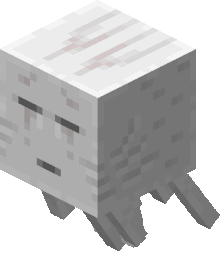Project Summary
The game will set up a continuely respawning ghast floating in the sky around 20 blocks away from the agent. The ghast will constantly shoot explosive fireballs to the agent every 3 seconds. A fireball will create a small but temporary igniting zone when it explodes. The fireball, however, can be bounced back if the agent hits it right in front of his face with a sword. The goal of the project is to let the agent learn how to survive under the fireball blast and find the best timing the hit back the fireball to kill the ghast. The agent will need to decide an action among swinging the sword once, waiting for the fireball to get closer, or dodging the fireball based on the information input at each frame.
Approach
We’re using the reinforcement learning with PPO algorithm from the Rllib with default model and settings.
\[\hat q(s, a) = \hat q(s, a) + \alpha[r + \gamma\max_a\hat q(s', a')- \hat q(s, a)]\]There are 100 steps at each episode, and there are three available actions for the agent at each step:
- Strafe right
- Strafe left
- Swing the sword once (attack)
The agent is rewarded based on whether the agent successfully dodges a fireball (reward + 0.5), hits back a fireball (reward + 1), gets hit by a fireball (reward - 1), or kills the ghast (reward + 3). The reward is determined by the returned value of <ObservationFromNearbyEntities> tag: the agent can only see the coordinate of each fireball, while the rewarding system can see some extra information like the motion of both the living ghast and the fireballs.
The reward system determines whether the agent has successfully dodged a fireball by comparing the fireball’s z values and the agent (i.e., check if the fireball flies past the agent). Secondly, the reward system determines whether a fireball has been hit back by checking the fireball’s z motion (because the fireballs are initially flying towards the agent, if there is a fireball flying in the opposite direction, it must be hit back by the agent). Lastly, determining whether the agent gets damaged or kills a ghast is rather simple: check their existence after each round. To make things easier, we give the agent the fire resistance at the beginning of each game to get extra punishment if it’s ignited accidentally.
At each step, the agent gets an observation array indicating each fireball’s position that is currently flying towards it. So far, we construct the array by concatenating every fireball’s x y z values, and we’ll try to figure out a better way to turn the observation into an array.
Last but not least, the system will spawn a new ghast after any of the original ghasts has been killed, so that if the agent performs well and kills all the ghasts quickly, instead of quitting and starting a new episode early, it can still receive more rewards in the same episode.
Evaluation
Here is the learning result after around 10,000 steps

To evaluate the project’s success, we are looking at the success rate of dodging and bouncing back the fireballs and the total number of kills. We currently reward the agent 0.5 points for one successful dodge, 1 point for hitting back the fireball, -1 point for getting hit, and 3 points for killing the ghast. The agent is expected to make random choices at first, and as the learning continues, the episode rewards should be improved over time. As you can see in the graph above, the returns fluctuate quite a bit. I believe this is partly because the total step (100) we set at each episode is not enough: we only spawn one ghast when testing, the shooting rate of a single ghast is 1 per 3 seconds, which means the total number of fireballs in each episode is relatively small, which limits the amount of valid training data. However, you can still see the upward trend of the curve in the graph. We believe, after making some necessary setting improvements and give it long enough time to do the training, the trend will be much more obvious.
Remaining Goals and Challenges
Firstly, as I mentioned in the previous section, each episode’s total steps/duration must be increased to reduce unstable returns. There are two options: 1) change the number of total steps in each episode, and 2) to set the time length of each mission by using the <AgentQuitFromTimeUp> tag. For me, the second option makes more sense because the ghast’s shooting rate is always the same, which means the duration of each mission is the direct factor of the total number of fireballs. Either way, we’ll need to do a lot of testing to find the optimal setting.
Secondly, we’re thinking of including the block detection in the step observations as well. In our current version, the agent may occasionally “stuck” into the walls when it keeps moving in one direction even though the agent is already at the edge of the platform. However, this will definitely increase the complexity of the states as there are more situations to consider.
Lastly, we’ll also need to figure out the different reward values that work the best for the trainer. Again, this will require us to do a lot more training and comparing the returns to decide the optimal parameters.



